1. Resnikoff S, Pascolini D, Mariotti SP, Pokharel GP. Global magnitude of visual impairment caused by uncorrected refractive errors in 2004.
Bull World Health Organ 2008;86:63-70.



2. Wang Q, Klein BE, Klein R, Moss SE. Refractive status in the Beaver Dam Eye Study.
Invest Ophthalmol Vis Sci 1994;35:4344-4347.

3. Attebo K, Ivers RQ, Mitchell P. Refractive errors in an older population: the Blue Mountains Eye Study.
Ophthalmology 1999;106:1066-1072.


4. Wu SY, Nemesure B, Leske MC. Refractive errors in a black adult population: the Barbados Eye Study.
Invest Ophthalmol Vis Sci 1999;40:2179-2184.

5. Wong TY, Foster PJ, Hee J, et al. Prevalence and risk factors for refractive errors in adult Chinese in Singapore.
Invest Ophthalmol Vis Sci 2000;41:2486-2494.

6. Zhao J, Pan X, Sui R, et al. Refractive Error Study in Children: results from Shunyi District, China.
Am J Ophthalmol 2000;129:427-435.


7. Maul E, Barroso S, Munoz SR, et al. Refractive Error Study in Children: results from La Florida, Chile.
Am J Ophthalmol 2000;129:445-454.


8. Pokharel GP, Negrel AD, Munoz SR, Ellwein LB. Refractive Error Study in Children: results from Mechi Zone, Nepal.
Am J Ophthalmol 2000;129:436-444.


9. Lin LL, Shih YF, Hsiao CK, et al. Epidemiologic study of the prevalence and severity of myopia among schoolchildren in Taiwan in 2000.
J Formos Med Assoc 2001;100:684-691.

10. He M, Zeng J, Liu Y, et al. Refractive error and visual impairment in urban children in southern China.
Invest Ophthalmol Vis Sci 2004;45:793-799.


11. Xu L, Li J, Cui T, et al. Refractive error in urban and rural adult Chinese in Beijing.
Ophthalmology 2005;112:1676-1683.


12. Saw SM, Chan YH, Wong WL, et al. Prevalence and risk factors for refractive errors in the Singapore Malay Eye Survey.
Ophthalmology 2008;115:1713-1719.


13. Vitale S, Ellwein L, Cotch MF, et al. Prevalence of refractive error in the United States, 1999-2004.
Arch Ophthalmol 2008;126:1111-1119.



14. Jobke S, Kasten E, Vorwerk C. The prevalence rates of refractive errors among children, adolescents, and adults in Germany.
Clin Ophthalmol 2008;2:601-607.



15. Krishnaiah S, Srinivas M, Khanna RC, Rao GN. Prevalence and risk factors for refractive errors in the South Indian adult population: the Andhra Pradesh Eye disease study.
Clin Ophthalmol 2009;3:17-27.



16. Pan CW, Wong TY, Lavanya R, et al. Prevalence and risk factors for refractive errors in Indians: the Singapore Indian Eye Study (SINDI).
Invest Ophthalmol Vis Sci 2011;52:3166-3173.


17. Wu JF, Bi HS, Wang SM, et al. Refractive error, visual acuity and causes of vision loss in children in Shandong, China: the Shandong Children Eye Study.
PLoS One 2013;8:e82763



18. Yoon KC, Mun GH, Kim SD, et al. Prevalence of eye diseases in South Korea: data from the Korea National Health and Nutrition Examination Survey 2008-2009.
Korean J Ophthalmol 2011;25:421-433.



19. Kim EC, Morgan IG, Kakizaki H, et al. Prevalence and risk factors for refractive errors: Korean National Health and Nutrition Examination Survey 2008-2011.
PLoS One 2013;8:e80361



20. Saw SM, Katz J, Schein OD, et al. Epidemiology of myopia.
Epidemiol Rev 1996;18:175-187.


21. French AN, Morgan IG, Mitchell P, Rose KA. Risk factors for incident myopia in Australian schoolchildren: the Sydney adolescent vascular and eye study.
Ophthalmology 2013;120:2100-2108.


22. Rasmussen OD. Incidence of myopia in China: data and theses from periodical investigations covering thirty years residence, and association with refracting and hospital centres, in a score of the larger cities.
Br J Ophthalmol 1936;20:350-360.



23. Wu HM, Seet B, Yap EP, et al. Does education explain ethnic differences in myopia prevalence? A population-based study of young adult males in Singapore.
Optom Vis Sci 2001;78:234-239.


24. Sawada A, Tomidokoro A, Araie M, et al. Refractive errors in an elderly Japanese population: the Tajimi study.
Ophthalmology 2008;115:363-370.e3.


25. Dandona R, Dandona L, Naduvilath TJ, et al. Refractive errors in an urban population in Southern India: the Andhra Pradesh Eye Disease Study.
Invest Ophthalmol Vis Sci 1999;40:2810-2818.

26. Tarczy-Hornoch K, Ying-Lai M, Varma R. Myopic refractive error in adult Latinos: the Los Angeles Latino Eye Study.
Invest Ophthalmol Vis Sci 2006;47:1845-1852.


27. Vitale S, Sperduto RD, Ferris FL 3rd. Increased prevalence of myopia in the United States between 1971-1972 and 1999-2004.
Arch Ophthalmol 2009;127:1632-1639.


28. Saw SM, Gazzard G, Koh D, et al. Prevalence rates of refractive errors in Sumatra, Indonesia.
Invest Ophthalmol Vis Sci 2002;43:3174-3180.

29. Katz J, Tielsch JM, Sommer A. Prevalence and risk factors for refractive errors in an adult inner city population.
Invest Ophthalmol Vis Sci 1997;38:334-340.

30. Wensor M, McCarty CA, Taylor HR. Prevalence and risk factors of myopia in Victoria, Australia.
Arch Ophthalmol 1999;117:658-663.


31. Rim TH, Woo YJ, Park HJ, Kim SS. Current status and future expectations of cataract surgery in Korea: KNHANES IV.
J Korean Ophthalmol Soc 2014;55:1772-1778.

32. Wen G, Tarczy-Hornoch K, McKean-Cowdin R, et al. Prevalence of myopia, hyperopia, and astigmatism in non-Hispanic white and Asian children: multi-ethnic pediatric eye disease study.
Ophthalmology 2013;120:2109-2116.



33. Gupta A, Casson RJ, Newland HS, et al. Prevalence of refractive error in rural Myanmar: the Meiktila Eye Study.
Ophthalmology 2008;115:26-32.


34. Fotouhi A, Morgan IG, Iribarren R, et al. Validity of non-cycloplegic refraction in the assessment of refractive errors: the Tehran Eye Study.
Acta Ophthalmol 2012;90:380-386.


35. You QS, Wu LJ, Duan JL, et al. Factors associated with myopia in school children in China: the Beijing Childhood Eye Study.
PLoS One 2012;7:e52668





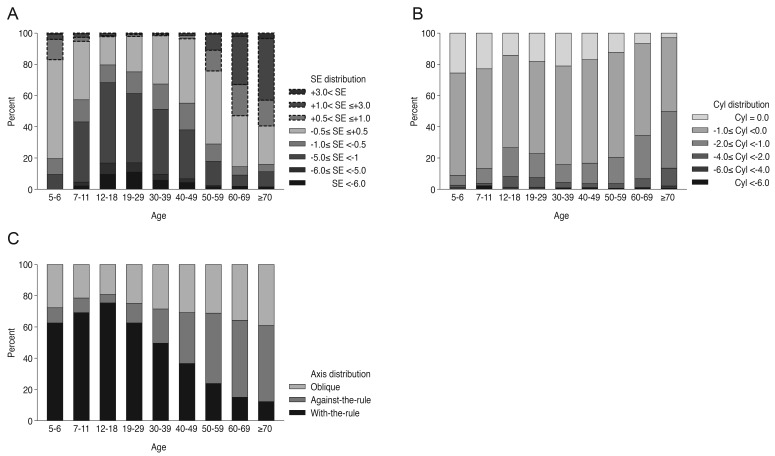
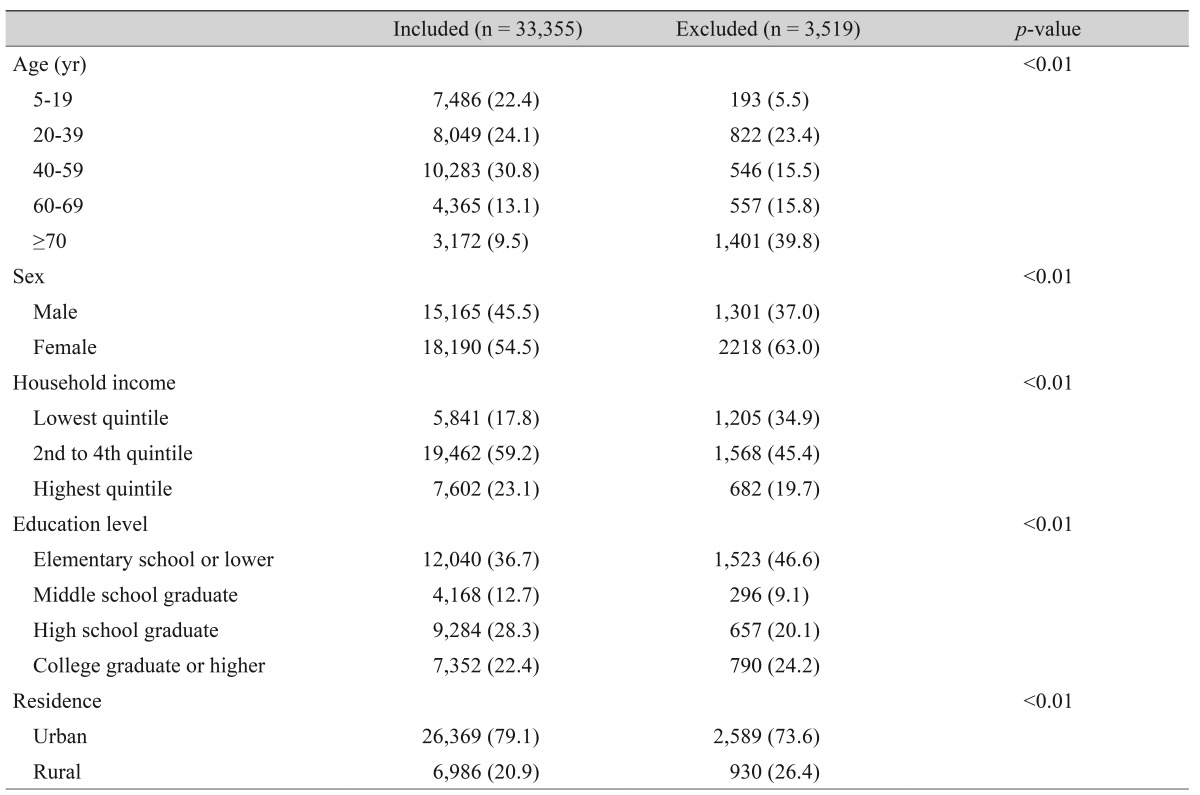
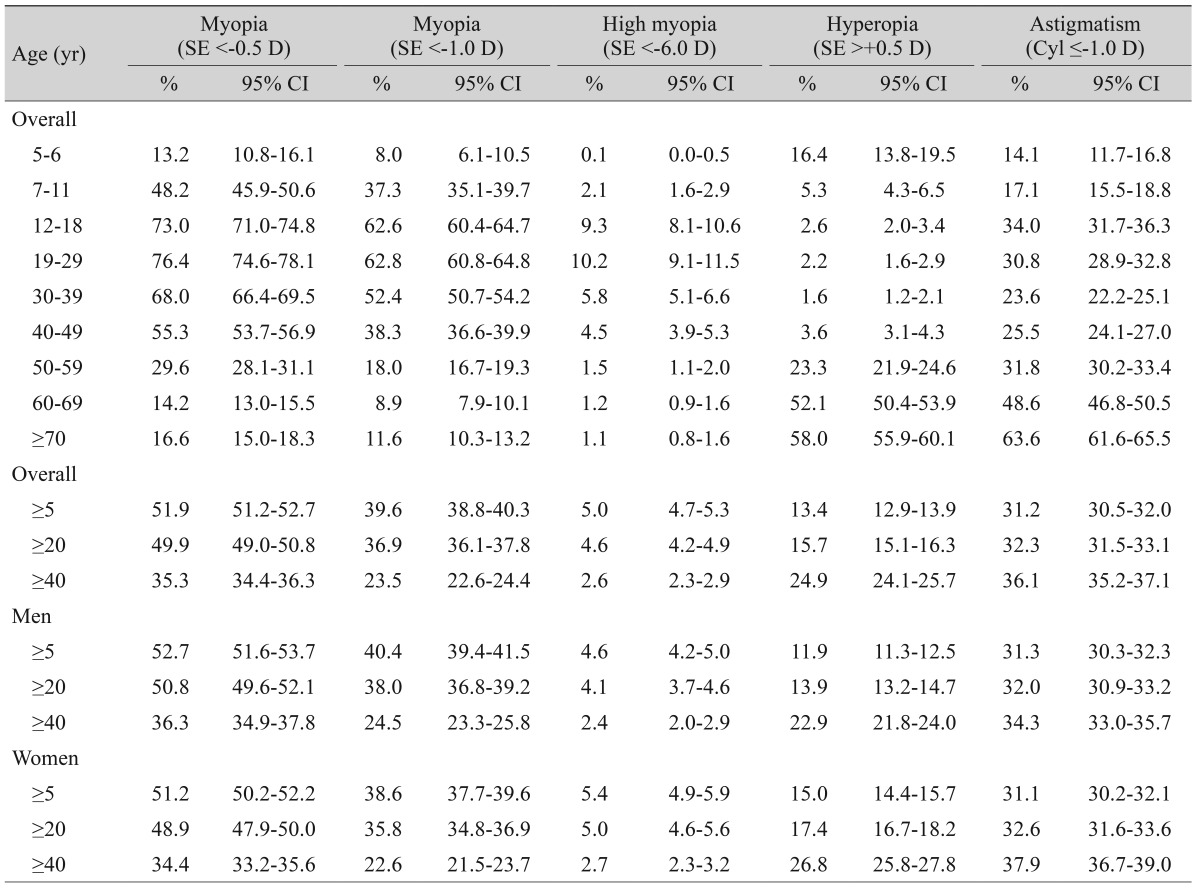
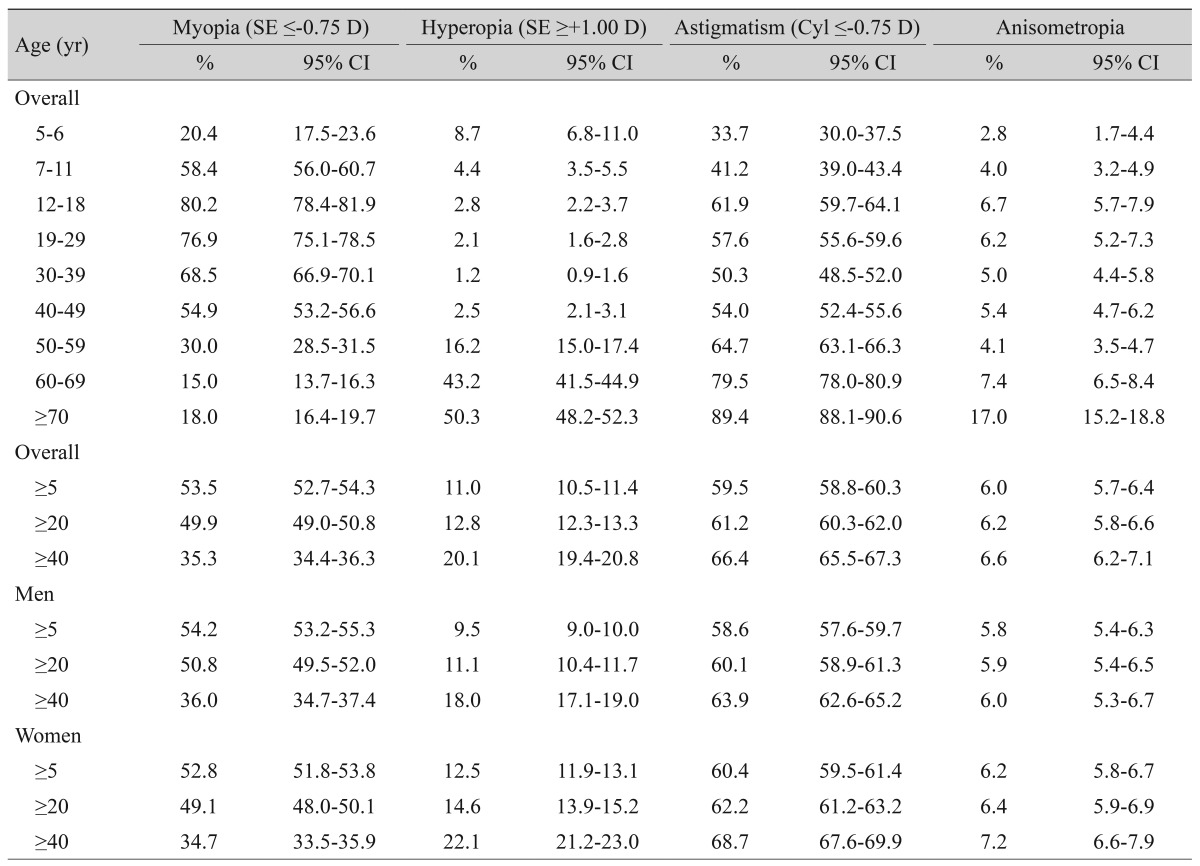



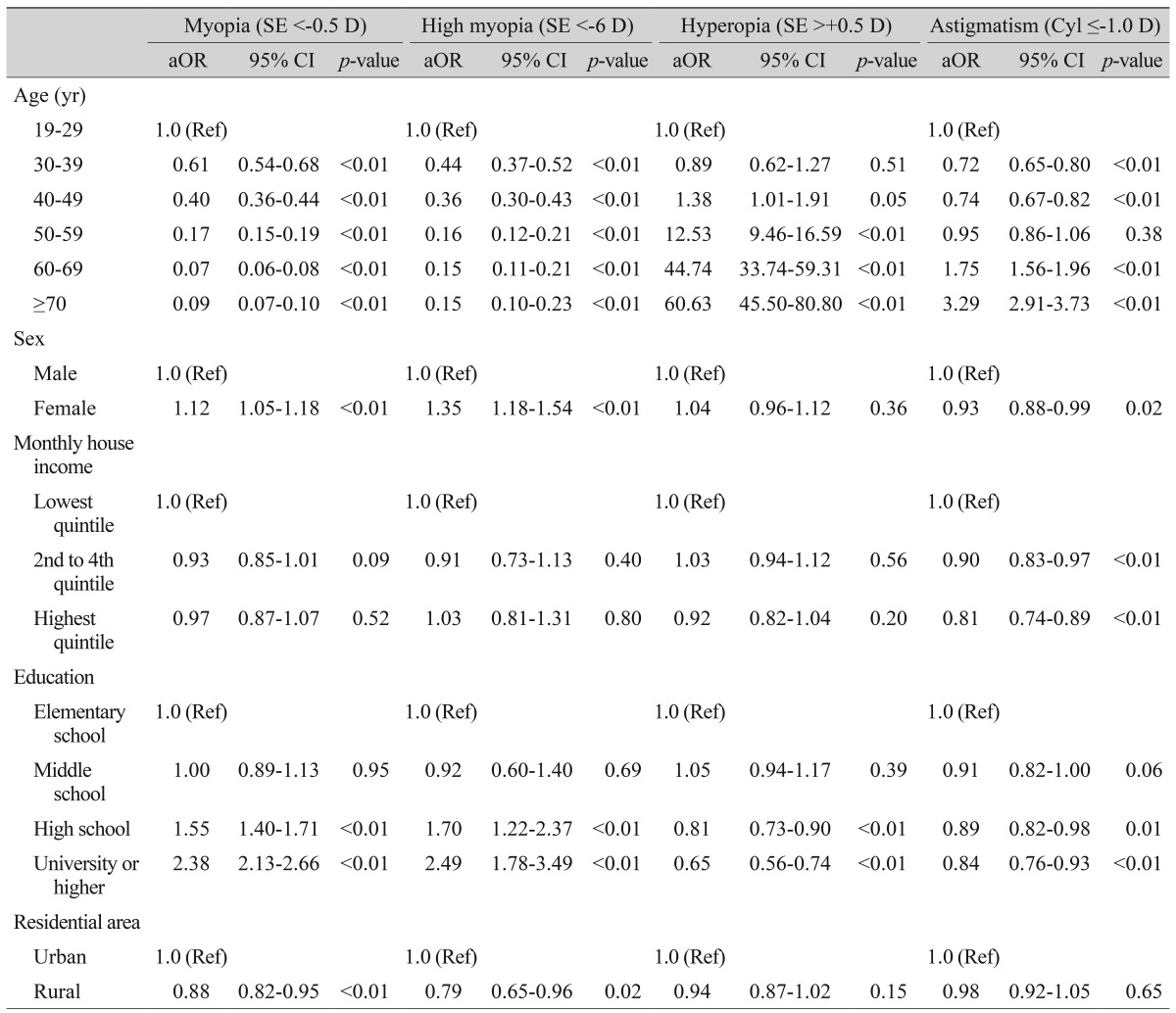
 PDF Links
PDF Links PubReader
PubReader Full text via DOI
Full text via DOI Full text via PMC
Full text via PMC Download Citation
Download Citation Print
Print




